You may find rangoli’s being drawn outside your house usually during festive times. It acts as a polish to the whole festive celebrations. Whenever someone enters your house, the first impression is made from the Rangoli itself. Red, orange, pink, yellow gulal colours or the beautiful petals of flowers like mogra, rose, marigold, etc, rangoli can be made from everything and anything.
Rangoli is also made from rice, wheat flour, sand, etc. That’s the beauty of their evergreen decoration. Today, we will learn about the origin of rangoli and its diversification. So, let’s start!
Origin of Rangoli
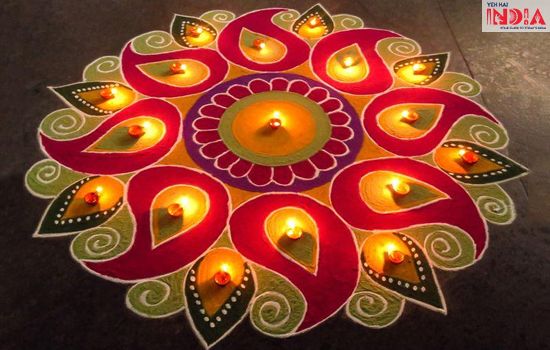
Rangoli was originated in the Indian subcontinent and it’s a Sanskrit word which means creative expression of art with the help of colours. It’s believed that the earliest symbolic representation of rangoli was done by a king. He was asked to draw a portrait of his son on the floor by Lord Brahma, so that he could breathe life into the painting.
Recommended Story – Dhanteras 2020: Why Indians Celebrate It? Historical Significance And Modern Celebrations
According to the legend recorded in Chitra Lakshana, that was the first portrayal of floor painting using flowers, colours, etc, which is now improvised and called ‘Rangoli’.
Diverse forms of Rangoli
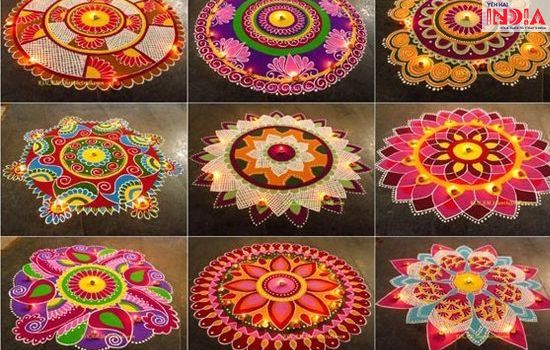
Rangoli is also known as Chowk Purana in Northern India, Aripana in Bihar, Mandana in Rajasthan, Kolam in Southern India, and Alpana in Bengal. The names are as diverse as its constituents. In Maharashtra, people earlier used to make rangolis on daily basis.
It brings positive vibes and act as a heart-warming welcome for the guests. Every state has its own way of making rangoli in the utmost beautiful way. So, let’s learn their techniques of making variant rangoli designs.
1. Chowk Purana from Uttar Pradesh
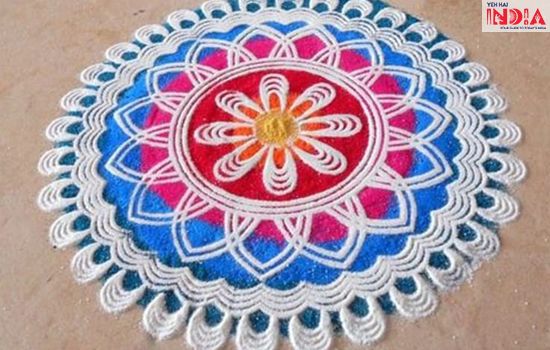
Well, Chowk Purana is quite similar to the subject you learned in school, i.e. Geometry. Remember how you used to draw circles using compass, in chowk purana, the only difference is you don’t have a compass.
The rest base process is just the same. You need to connect dots and form a base; the add-ons just add a sparkling effect to the rangoli. Usually, chowk purana is a well structured rangoli in a circular frame.
It’s the traditional form of art in Uttar Pradesh. This symmetrical rangoli is then completed with the help of colours. The more you experiment with colours, the more it turns out to be the best.
2. Muruja/ Jhoti/ Chita from Odisha
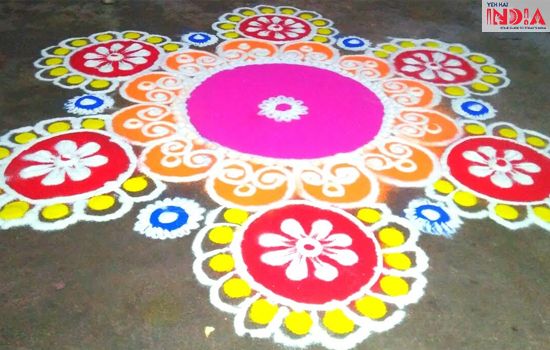
Jhoti/ Chita is a bit different from other rangolis. This Odiya rangoli involves the use of a semi liquid paste of pithau or rice to make the white line art and people use brushes instead of fingers to add a grounded and natural effect.
Recommended Story – Durga Puja Festival
Lotus, elephants, floral patterns are all characteristics of a Jhoti. Also, the footmarks of goddess Lakshmi is a must in any Jhoti. Through out the year, the women of the house draw different motifs for different occasions. It’s said to be a connection between mystical and materialistic form.
On the other hand, Muruja rangoli patterns mostly are dedicated to Lord Jagannath or Lord Krishna. They are drawn near the Tulsi plant, which according to Hindu mythology, is considered sacred.
For this rangoli you need to pay focus on small details and also keep in mind the theme and connection. The role of colours is a major thing which one can’t ignore in Muruja. Women in Odisha make outstanding rangolis not only on floor but walls too.
3. Mandana from Madhya Pradesh and Rajasthan
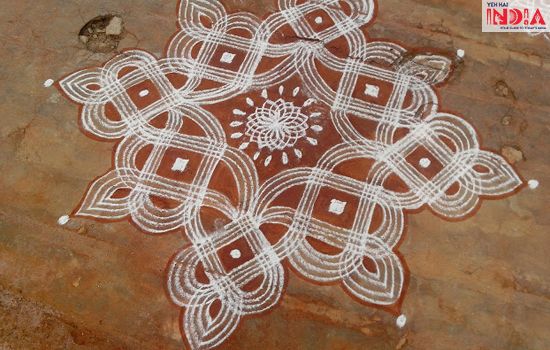
Mandana style represents the tribal form of art famous in the rural areas of Madhya Pradesh and Rajasthan. Even now, it’s quite trending because you don’t need much experience when it comes to making Mandana rangoli. It’s simple, subtle, and classic form of Rangoli.
All one need is a block/ floor plastered with clay and then painted with red. The base is usually drawn using chalk powder and then the rangoli is filled with colours of one’s choice. It’s the most simplest form but reminds one it’s roots and traditions.
4. Kolam from Tamil Nadu

Well, Kolam may be one of the single coloured rangolis but it gives a lot of room for creativity, ideation of thoughts to be put down in the form of floor painting. It’s not as sophisticated as other but the plain white rangoli has its own variant forms.
One has no boundaries when it comes to making Kolam, freestyle designs or patterns, you may see a lot of variation.
5. Alpana from Bengal
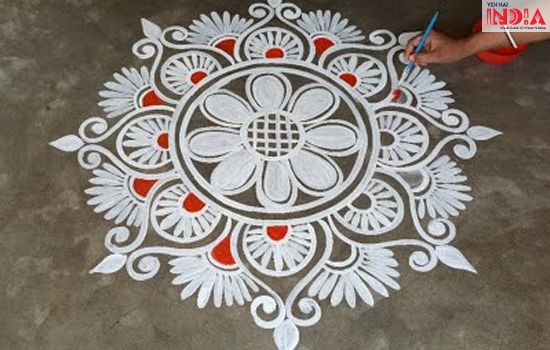
Like Kolam, Alpana too has dominance of white colour over any other colour. This is because white represents peace and connection and is more soothing than any other colour. The white colour isn’t made from dyes or petals, but rice powder mixed with water to give it a liquid form.
If you like to keep your rangoli simple, then Alpana is just the right one for you. Alpana is usually a detailed, meaningful pattern drawn on a black/ dark background. Nowadays, people even add small hints of red/ green colours to give the whole rangoli a nice finish.
Alpana’s are really huge rangolis and are made with love and devotion.
One can try any of the traditional forms mentioned above, but rangoli isn’t restricted to only these forms. You can draw anything and fill it with the material of your choice.
Trending: Eco-friendly Rangolis
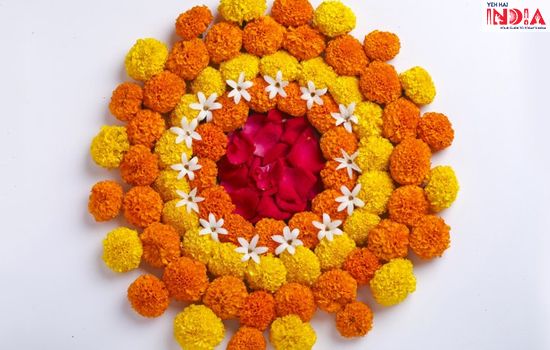
Eco-friendly rangolis are now a trending thing, so people use petals of flowers and rice, flour, etc, instead of using gulal or coloured sand powders. Though they look really beautiful but some of them have certain impurities which can damage eyes when one cleans/ makes the rangoli.
Also, certain sand artists on beach make rangolis with the help of sand and explore their niche. Rangolis are mostly made on Diwali to pay tribute to Goddess Lakshmi and Lord Ganesha.
Except for Diwali, people also make rangoli on Rakhi, Independence Day, Republic day and several other occasions. During the national festivals, Indian flag is made with the help of colours and petals, which instils the feeling of patriotism and celebrated art and culture of India in its true form.
Go for any design you like or start drawing something, add a touch of colours, petals, and there you go, your stunning rangoli is ready to welcome all the special guests coming in this festive season!
Also Read – The Hindu New Year











You made some respectable points there. I looked on the web for the problem as well as found most people will support with your internet site. Ondrea Norbie Sommers